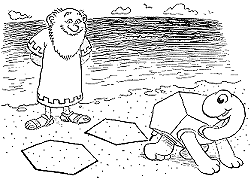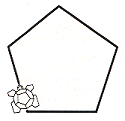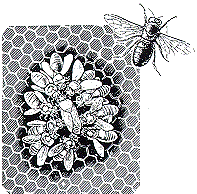
|
Feedback Form

MORE ADVENTURES OF MYRTLE THE TURTLE AND THE TIME MACHINE

Chris Gregory Senior Lecturer in Mathematics at Bradford and Ilkley Community College continues his series on Turtle Graphics. In this first article of Geometry Microworld Part III he starts his look at regular polygons (shapes in which all the angles and all the edges are equal).

Myrtle the Turtle has travelled back in time. She's met various people who she's helped to invent geometry. Now she continues on her travels...
After drawing the plans for the Pyramids Myrtle climbed back into her time machine and set off once again. This time the journey was short and the machine landed on a beach. It was hot. So Myrtle paddled out to sea and lay on her back and watched the clouds float by. She was disturbed by a man on the beach, waving a stick. Myrtle swam to the shore.
He had been drawing strange shapes in the sand and was jumping on them yelling, "Polygon! Polygon! Polygon!"
"What's the matter? Have you lost your parrot?"
"Parrot? Carrot? Humph! I'm Pythagoras the famous mathematician but I can't draw a polygon. I'm thinking of giving maths up and opening a little cafe on the sea front."
"I can draw polygons" said Myrtle.
"What! You?" Pythagoras stared at Myrtle. "They have to be regular polygons - that is shapes with all the sides the same length and all the angles the same."
"Easy," said Myrtle, "You need to work it out before you start. How many sides should we try?"
"Five."
Myrtle's processor hummed, she calculated the angles and the sides, then drew a perfect pentagon. Pythagoras scribbled in the sand. An hour later the beach was covered in polygons. Pythagoras stopped. "Polygon. Hmm! That's a good name for a cafe."
"How about, 'the Arndale Centre'?" suggested Myrtle.
• POLYGONS AND PATTERNS:
Polygons (closed shapes with straight edges) are the 'natural' shapes
for Turtle since it can only move in straight lines. Geometry Microworld
Part 1 deals with irregular polygons (closed shapes where the angles and
the sides are not the same). The irregular polygon activities demonstrates
the difficulties associated closing a shape - that is a Turtle starting
and finishing a journey at the same point.
Regular polygons (shapes in which all the angles and all the edges are equal) are much more predictable and manageable. Constructing them can lead to a number of worthwhile activities.
 • Draw a Pentagon
• Draw a Pentagon
Write a procedure PENT to draw a pentagon - a regular polygon with five
edges. Look at the procedures SQUARE and TRI (GO p1 issue 6). These draw
regular polygons with four and three edges respectively. Can you see how
to adapt them?
The 'standard' solution is:
TO PENT :SIDE
REPEAT 5 [FD :SIDE RT 72]
END
Arriving at this may take a great deal of discussion and experimentation.
What will need to be grasped along the way is a basic result about turning which Seymour Papert has referred to as the 'Total Turtle Trip Theorem' - that, whenever the Turtle goes for a walk and returns to its starting point, it has turned through a total angle of 360 degrees.

a + b + c + d + e = 360 degrees
Therefore, for a regular pentagon, each turn must be 72 degrees.
Note that, in formal geometrical terms, the angles to be considered are the external angles of the polygon since it is these which indicate how far the Turtle has turned at each corner.
Once PENT has been mastered, an obvious next step is to try to adapt what has been learned to the writing of further procedures for drawing regular polygons with greater numbers of edges.
eg.
HEX - regular hexagon (6 edges)
OCT - regular octagon (8 sides)
ENN - regular enneagon (9 edges)
DEC - regular decagon (10 edges)
DODEC - regular dodecagon (12 edges)
Some children may even like to consider the regular heptagon (7 edges) and regular hendecagon (11 edges). If so, it will be helpful to have a calculator available!
 Ask the pupils for examples of regular polygons |
• Other Activities
There are many benifits in reinforcing this work through assolated activities.
For example children may find the names quite intriguing - they all indicate
the curiosity in geometry characteristic of the Classical Greek Mathematics
of the fourth and fifth centuries B.C. Studying the relevant historical
aspects of that era adds interest to the work.
| Back |
|---|